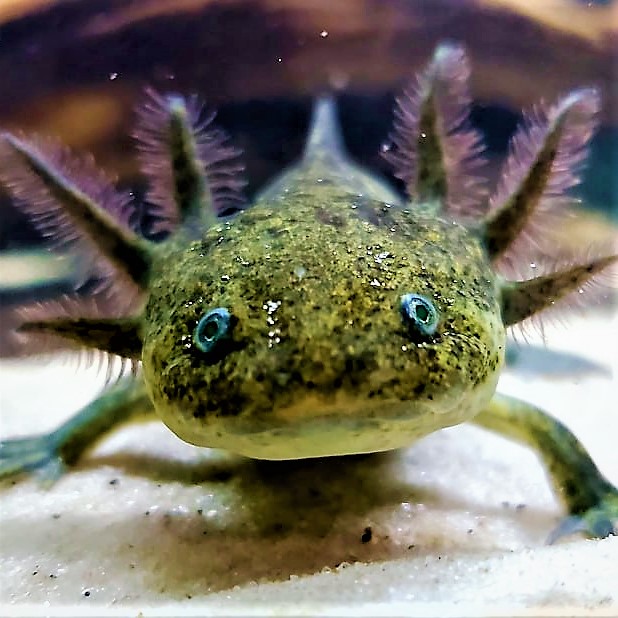
Loki, a Wild Type Axolotl stares through the glass of his aquarium on Thursday.
Axolotls are amazing creatures. If they lose a body part, it usually grows back! Rosemary Whitney has been an axolotl breeder for one year. “What is an axolotl?” you may be asking. Well, Whitney knows all about them! Whitney said, “Axolotls are an endangered species of salamander that are native to only a single lake in Mexico.” But unlike the salamander, axolotls never lose their frilly gills on their heads and remain water-dwelling their entire lives.
There are not many axolotls left in the wild. “Due to pollution in their natural habitat, it is estimated that there are less than 300 left in the wild. Fortunately, over 150 years ago axolotls caught the interest of research scientists and they have been bred and kept in the scientific community for decades. Because of their usefulness in research, these frilly little guys still exist today and have even made a place for themselves in the pet trade as well,” Whitney said.
Axolotls prefer a very specific environment. Whitney said, “As far as keeping an axolotl goes, having the proper tank setup is a must. They are bottom dwellers, so the more space and places to explore at the bottom of the tank, the better! They love hides and toys, and I have even seen some people put underwater hammocks in their tanks! Since they are native to cold water lakes, it is imperative that their water is kept as cool and calm as possible. Although they can stand higher temperatures, temperatures above 70 degrees can make them really stressed and lower their immune system, making them more prone to fungus and disease.”
Axolotls often do better in their own aquariums. Whitney added, “Some people try to add axolotls to an aquarium they already have set up. This can be dangerous for all critters involved. Axolotls will try to eat anything they can fit in their mouths, so gravel, snails, and fish are not safe, and fish will often think an axolotl’s frilly gills look yummy!
If you are thinking about getting an axolotl as a pet, here are five things that Whitney suggested to keep an axolotl happy and healthy:
1) A large tank, 20+ gallons for one, and add at least 10 for each additional axolotl.
2) Fun decorations and places they can hide.
3) A cool location in the house (with a fan or chiller if necessary).
4) A filter with as little current flow as possible.
5) If you want them to have buddies, only other axolotls should be housed with them.
There is lots to discover about axolotls. “Thanks to science, we still are able to learn about these amazing creatures. With a little research and effort, we can take them home too! There is a thriving axolotl community in the Seattle and Portland areas, and they are starting to become more available in Southern Oregon,” Whitney said.
Axolotls make great pets! Whitney said, “The axolotl population is growing and people are becoming more interested in them as pets. Their expressive faces, perpetual smiles, and frilly gills won me over the first time I saw one and I think they make fantastic pets. While they do have some unique needs, their care is relatively easy and they are so much more interactive than other aquatic pets. They learn to recognize their owners and can even learn some tricks!”
If you are interested in purchasing an axolotl, you can go to Atlantis Pet Store or contact Rosemary Whitney at 3ec52506e783315296f831bf3227029e@comm.craigslist.org
Thor, a Golden Albino Axolotl relaxes in his tank on Thursday.
Loki, a Wild Type Axolotl climbs against the glass on Thursday.
Loki, a Wild Type Axolotl swims around his enclosure on Thursday.
Thor, left, and Loki sitting nose to nose in their tank on Thursday.